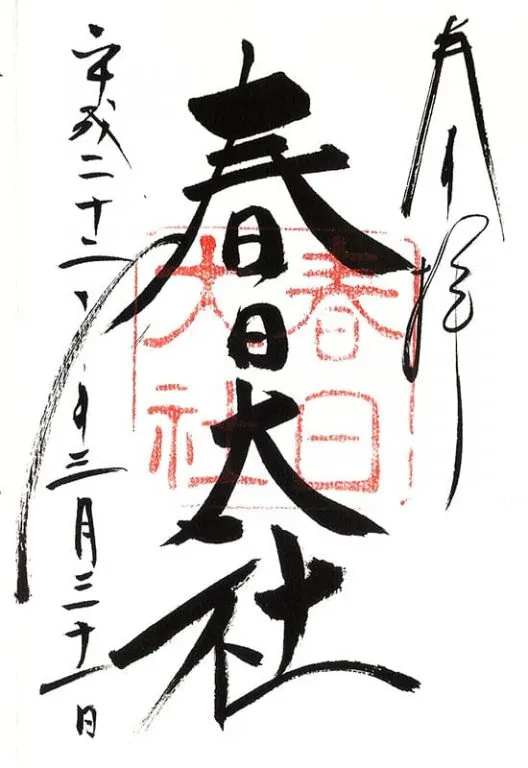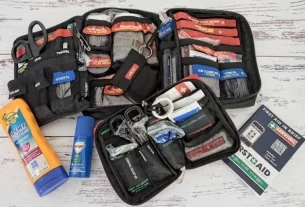
If you’re looking for a unique and interesting souvenir of your travels in Japan then a shrine and temple stamp book might be just what you’re looking for. In Japanese, it’s known as a goshuincho (御朱印帳) meaning red stamp book or just shuincho, temple stamp book.
The books are traditionally used by pilgrims to record their journey but they’re also a fantastic way to record your own travels around Japan’s historic temples and shrines.
Collect Shrine and Temple Stamps
The stamps and calligraphy are always done into the shuincho, an accordion-style book that usually fits 46 stamps. The books are filled in the Japanese style working forward from what, in the west, we would consider the back of the book. One cover will usually feature a picture and oblong piece of paper on the top left of the cover, with that side up it opens to the right.
I was determined that I MUST purchase a goshuincho when we arrived in Japan for our first visit in 2010. I’ve continued to collect the stamps throughout our years of travels in Japan and more recently I ended up buying a second book when I forgot to pack mine.
You can buy the shiuincho books at most major temples and shrines. To buy a book you would ask at the shop counter “shuincho kudasai” – a temple stamp book, please. The price varies a bit but they’re usually around Y1000 – Y1500 and the purchase of the book includes your first stamp.
Some temples have more ornate books than others and I had originally hoped to get one of the more decorative styles depicting seasonal flowers or birds but I also wanted to buy it at our first temple so I could start collecting stamps right away.
Mine is from Sanjusangendo Temple in Kyoto and has a linen cover with the famous long wooden building debossed into the cover in gold. I am very happy that my first goshuin is from that particular temple. If you have ever been you will know that it is quite overwhelming to visit, you step inside an unassuming wooden hall and it is literally packed with life sized statues and treasures within. There is no photography inside the temple so my temple stamp and book is extra meaningful as a memory of our visit.

At each major Buddhist temple or Shinto Shrine you visit, you then get a page in your book completed. That involves one or more red seals being stamped into the book with hand calligraphy added showing other details including the date. Usually, they are stamped and the calligraphy is done in front of you directly onto the next page in your book although some of the smaller temples that only have a few special opening events during the year will have them preprepared for you to insert into your book later.
If you get a pre-prepared page I’d suggest slotting it directly into the correct page in your book even if you aren’t able to stick it down immediately so the next temple’s red seal will be added around it. I had one of mine safely in our hotel room and tried to ask for a blank page to be left but books are always completed in date sequence without gaps or other addtions so with my lack of ability to communicate in Japanese I have ended up with that one now out of order.
Each seal usually costs between Y300 and Y500 so it’s a reasonably priced souvenir considering how unique it is. Rarely a seal can cost up to Y2000 when it is particularly ornate or celebrates a festival at the temple, the price will be displayed near when you purchase them so you can see the cost and sometimes options, in advance.

To get a page completed in your book you will go to the area near the front of the temple that has the charms and fortunes and ask “shuin kudasai” If there’s a bit of a language barrier having your book in your hand will help. Sometimes in busier temples you will be given a token to come back later and collect the book but usually it is prepared while you watch. If you receive a token just step back and wait out of the way until your number is called or the person on the counter indicates for your to collect it.
Occassionally there will be a long queue like the one above but this is very rare. This is at Diagoji Temple in southern Kyoto on the day of the cherry blossom festival. The cherry trees were in peak bloom, a parade re-enacting a feudal period tea party had just taken place and the temple at the top of the hill here is the 11th stop on the Saigoku Kannon pilgrimage in Western Japan. This all made for a super busy day at the temple and a date many visitors would want to collect the commemorative stamps.
Not every shrine and temple offers Goshuin, it is mainly the larger ones what are popular with tourists, or on a pilgrim trail. Some Buddhist denominations don’t do it, modern city temples generally don’t and smaller shrines and temples may not have them. That said I have been surprised at the memorable spots off the tourist train where I have been able to have a seal added like a small temple off the path on the walk up to Minoo Falls and waiting off to the side half way up Mt Misen and realising I wasn’t being looked at with curiosity because I was foreign but because a deer had wandered out and laid down beside me without me noticing.
Etiquette around Temple Stamps
The temple book is a record of visiting the various shrines and temples, it’s not a religious book or artifact so it’s suitable for anyone, you don’t need to identify as Buddhist or Shinto to own and use one. However, the book and process is always treated with respect and reverence.
Each addition to your book is a personalised piece of art crafted by the individual creating the seals that day, often it is a monk of the temple. If you have the opportunity stand quietly and watch the process, handing across the book and accepting it back with respect for the artist and the goshuin.

Never take a photo of the person preparing the stamp or the process without receiving permission first, usually it wouldn’t be allowed but we did have permission for the one on this page.
While temples and shrines in Japan are frequently visited by tourists and are welcoming to all, remember that you are in a spiritual place and observe the usual shrine protocols for visitors.
Temple stamps will only be added to a temple stamp book, don’t ask for it to be stamped into your travel journal or other book. You also shouldn’t write or add anything else into the pages of your Goshuincho. When a stamp is added a piece of loose paper will usually be added to that page, sometimes this will be blank, it can be an information sheet on the temple, a picture or something else. You may want to keep it in there but if you are going to remove it leave it until later, caligraphy is done with liquid ink and can take some time to dry properly and you don’t want it to transfer to the facing page.
I also have a loose piece of vellum paper with my book that is printed with the names, dates and location of the temples in the order that they appear in the book. As I don’t read Japanese I will need this in time to remember where each of them are from and it is the most discrete way I have found to do it. I carry my book in a fabric case to protect it and put the index in there, adding to it after each trip.
Shinto Shrine and Japanese Temple Stamps
I plan to progressively collate my shrine and temple stamps here in one place and have quite a few more to photograph and add. I’ve included a few for now to get started but will update those I already have and as I collect more below. I have also linked to more information where I can about each location.
Remember that each stamp is unique to the person who scribed it into your red seal book, the date, season and events happening at the temple at that time, therefore you may have a seals and calligraphy from the same temple that look quite different although there will usually be common identifiers within it.

Nara
31 March 2010

Nara
31 March 2010



